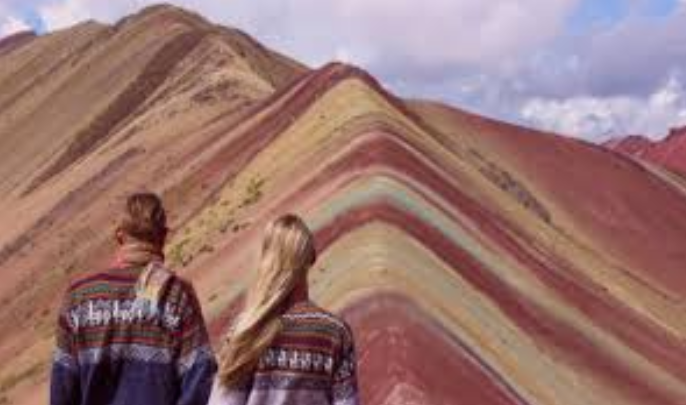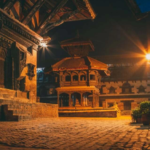Deep within the Peruvian Andes, where oxygen thins and clouds drift below your feet, exists a mountain that defies conventional expectations. Rainbow Mountain, known locally as Vinicunca or Montaña de Siete Colores, displays nature’s palette in horizontal bands of crimson, mustard yellow, seafoam green, and lavender. This geological phenomenon has transformed from an obscure Andean peak into one of South America’s most photographed natural wonders, captivating adventurers who brave thin air and challenging terrain to witness its otherworldly beauty.
The Mineralogy Behind the Magic
Understanding Rainbow Mountain requires diving into the science of sedimentary geology and mineral oxidation. The mountain’s distinctive appearance results from different sedimentary layers containing specific mineral compositions that produce varied colors when exposed to weathering. The rusty red and pink bands that dominate the mountainside come from iron oxide—the same compound that causes metal to rust. These iron-rich layers formed when the region was covered by ancient seas, with iron particles settling into sediments over countless millennia.
Yellow and gold streaks indicate sulfur deposits mixed with iron sulfide, creating brilliant ochre tones that contrast sharply with surrounding hues. The turquoise and jade-green bands, perhaps the most striking of all, result from copper sulfate compounds that have oxidized over time. These copper minerals react with oxygen and water to create the distinctive blue-green patina similar to what appears on aged copper roofs. White layers contain calcium carbonate and sandstone, while the darker maroon and purple sections reveal a combination of clay minerals, manganese, and additional iron compounds.
These colorful strata accumulated over approximately 65 million years during different geological epochs. Originally deposited horizontally on ancient ocean floors, these layers were subsequently folded, compressed, and thrust upward during the formation of the Andes Mountains. The collision between the Nazca Plate and the South American Plate generated immense pressure that lifted seafloor sediments to dizzying heights, tilting them at dramatic angles. Millions of years of erosion then stripped away softer overlying rock, exposing the mineral rainbow we see today.
A Climate Change Chronicle
Rainbow Mountain’s visibility as a tourist destination is intimately connected to climate change. Historical records and accounts from older community members indicate that the mountain was covered by glacial ice and permanent snowpack until the early 2000s. Rising global temperatures caused these glaciers to retreat rapidly, progressively unveiling the colorful geological layers beneath. What remained hidden for millennia became increasingly visible over just two decades.
This glacial retreat serves as a tangible indicator of environmental change in the region. While it has created a spectacular tourist destination, it also represents a concerning trend affecting mountain ecosystems worldwide. The loss of glacial ice impacts water availability for downstream communities, alters local microclimates, and changes the landscape in ways that will affect future generations. Rainbow Mountain thus becomes both a destination and a cautionary tale about our changing planet.
The mountain’s emergence into public consciousness occurred around 2013-2015, when intrepid travelers and photographers began sharing images on social media platforms. The response was immediate and overwhelming. Images of the striped mountain seemed almost too fantastical to be real, prompting skeptics to question their authenticity. Yet the mountain is entirely natural, with no artificial enhancement—simply a geological masterpiece revealed by retreating ice.
The Pilgrimage to 17,000 Feet
Reaching Rainbow Mountain demands physical preparation and mental determination. The journey typically begins in Cusco, situated at 3,400 meters elevation. From there, visitors travel roughly 100 kilometers through rural Andean landscapes to reach the trailhead at Phulawasipata or nearby access points. The drive alone takes three hours, passing through traditional villages where time seems to move at a different pace.
The actual trek covers between four to six kilometers depending on the starting point, but this modest distance becomes an epic challenge at extreme altitude. Rainbow Mountain’s summit sits at approximately 5,200 meters—higher than any peak in the lower 48 United States and comparable to Everest Base Camp. At this elevation, atmospheric pressure drops significantly, meaning each breath delivers only about half the oxygen available at sea level.
Altitude sickness affects people unpredictably, regardless of fitness level. Symptoms include pounding headaches, nausea, dizziness, fatigue, and shortness of breath. Serious cases can develop into life-threatening conditions like pulmonary or cerebral edema. Acclimatization is not optional—it’s a medical necessity. Spending two to three days at moderate altitude before attempting the trek allows the body to increase red blood cell production and adjust cardiovascular function.
The trail begins relatively gently, winding through valleys where herders graze alpacas and llamas against a backdrop of snow-capped peaks. Traditional stone and adobe houses with thatched roofs dot the landscape. As elevation increases, vegetation becomes sparse, then disappears entirely, leaving only rock, gravel, and hardy lichens. The final approach involves steep switchbacks that leave even fit hikers gasping.
Weather conditions add another layer of challenge. Mountain weather changes rapidly and without warning. Clear blue skies can transform into whiteout snowstorms within minutes. Temperatures fluctuate wildly—warm in direct sunlight but plummeting to freezing when clouds roll in or wind picks up. Many visitors underestimate these conditions and arrive unprepared, leading to miserable experiences or dangerous situations.
Community and Culture
The indigenous communities surrounding Rainbow Mountain have inhabited these harsh highlands for centuries, maintaining traditional lifestyles centered on herding and small-scale agriculture. For them, mountains are not merely geological features but living entities deserving reverence. In Andean cosmology, mountains are Apus—protective spirits that govern the land and influence human affairs. Rainbow Mountain holds particular spiritual significance, and offerings are regularly made to honor its power.
Tourism has brought unprecedented economic opportunity to these remote communities. Families that once struggled with subsistence living now earn income as guides, horsemen, cooks, and vendors. Young people have opportunities that didn’t exist a decade ago. Infrastructure improvements, including better roads and communication systems, have followed tourism development. Schools receive better funding, and access to healthcare has improved.
Yet this transformation isn’t without complications. Traditional social structures face pressure as commercial interests reshape community priorities. The sheer volume of visitors—sometimes over a thousand per day during peak season—strains the fragile mountain environment. Waste management, trail erosion, and preservation of the colorful slopes require careful attention. Communities and tour operators increasingly recognize that sustainable practices aren’t optional but essential for long-term success.
Preparing for the Experience
Successful Rainbow Mountain treks require careful planning. The dry season from May to September offers the most reliable weather, though even these months can bring unexpected storms. During wet season, snow and rain can obscure the colors entirely and make trails treacherous. Morning departures, typically between 3:00 and 4:00 AM, allow arrival at the summit when lighting conditions are optimal and before afternoon weather deteriorates.
Essential gear includes layered clothing for temperature regulation, waterproof jacket and pants, insulated gloves, warm hat, quality hiking boots, sunglasses, and high-SPF sunscreen. The intense UV radiation at altitude causes burns much faster than at sea level. Trekking poles help maintain balance on uneven terrain and reduce stress on knees during descent. Many visitors rent horses for part or all of the trek, particularly helpful for those struggling with altitude.
Key Takeaways
Geological Wonder: Rainbow Mountain’s colors represent 65 million years of sedimentary history, with each band telling a story of ancient seas, mineral deposits, and tectonic forces.
Climate Indicator: The mountain’s visibility results from recent glacial retreat due to climate change, serving as both tourist attraction and environmental warning.
Altitude Challenge: At 5,200 meters, proper acclimatization is essential for safety. Spend 2-3 days at moderate elevation before attempting the trek.
Cultural Significance: The mountain holds deep spiritual meaning for local Quechua communities as a sacred Apu, not merely a tourist destination.
Economic Impact: Tourism has transformed local economies, providing income opportunities while creating sustainability challenges that require careful management.
Preparation is Crucial: Success requires appropriate gear, physical readiness, weather awareness, and respect for the mountain’s dangers and fragility.
Best Visiting Season: May through September offers optimal conditions with clear skies and manageable trails during Peru’s dry season.
Sustainable Tourism: Preserving Rainbow Mountain for future generations demands responsible visitor behavior, waste management, and community partnership in conservation efforts.










